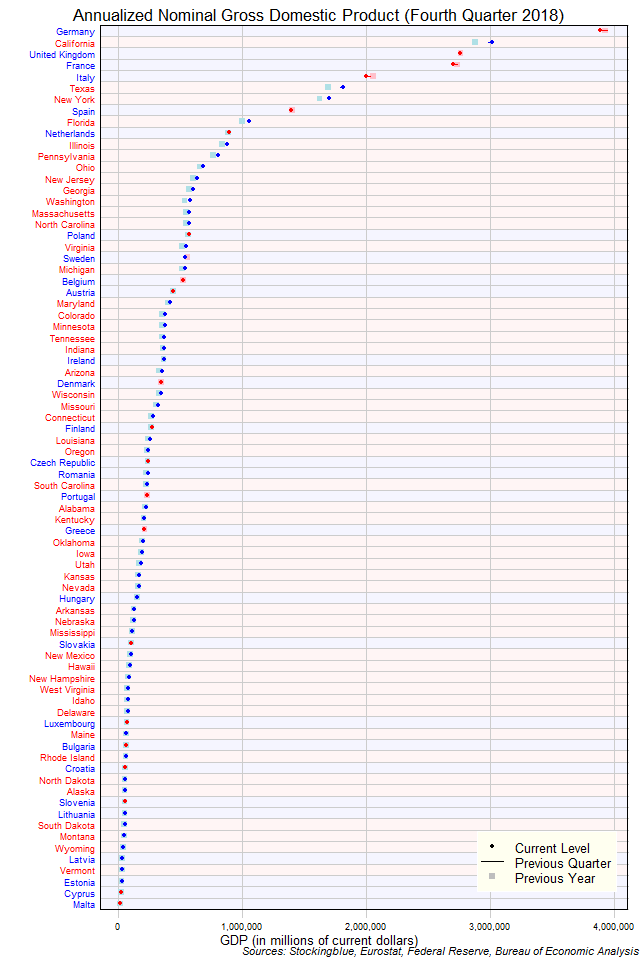
The chart above shows the annualized nominal gross domestic product (GDP) in each EU and US state as of the fourth quarter of 2018 in millions of US dollars, the change from the previous quarter, and the GDP one year prior. Only five states in both the EU and the US (four of which are from the EU) have an annualized GDP of over $2 trillion.
Findings
- The difference between the state with the largest GDP, Germany, and the state with the smallest, Malta, is $3,879,407 million (down from $3,935,126 million last quarter and down from $3,915,822 million last year). Germany and Malta had the largest and smallest GDP respectively both last quarter and last year.
- Germany has 269.73 times the GDP that Malta does. The ratio of largest GDP to smallest GDP was down from 270.80 last quarter and down from 287.40 last year.
- The median GDP in the 28 EU states is $238,779 million (down from $239,334 million last quarter and up from $235,776 last year) and the mean $653,350 million (down from $659,267 the previous quarter and down from $657,352 last year).
- The median GDP in the 50 US states is $238,726 million (up from $236,318 million last quarter and up from $227,751 last year) and the mean $412,287 million (up from $408,164 the previous quarter and up from $391,683 last year).
- The median GDP in the 78 EU and US states is $238,779 million (down from $239,296 million last quarter and up from $232,341 last year) and the mean $498,822 million (up from $498,304 the previous quarter and up from $487,051 last year).
- Fifty-seven states saw their GDP rise in current dollars from the previous quarter (50 from the US and seven from the EU) while 21 states saw their GDP drop in current dollars (all from the EU).
- Sixty-eight states saw their GDP rise in current dollars from last year (50 from the US and 18 from the EU) while ten states saw their GDP drop in current dollars (all from the EU).
- All EU drops in GDP with the exception of Sweden's annual drop and Greece's and Bulgaria's quarterly drop are attributed to currency rate fluctuations.
Caveats
- Data is from the fourth quarter of 2018.
- The data is seasonally adjusted in current dollars.
- Euros are converted to dollars at an average exchange rate of 1.14 for the fourth quarter of 2018, 1.16 for the third quarter of 2018, and 1.18 for the fourth quarter of 2017 according to historic rates listed at the Federal Reserve (see source link below).
- US data comes in an annualized format which the EU does not, thus EU data is annualized by multiplying the quarterly figure by four.
- US growth rates may differ from those provided by the Bureau of Economic Analysis as the BEA's growth rates are based on chained dollars in conjunction with the chain index or the quality index for real GDP. The growth rates listed here are based on nominal GDP.
- All figures are rounded to the nearest hundredth.
Details
In absolute terms, Germany saw the largest decrease over the previous quarter with a drop of $55,868.56 million. California had the largest growth with a gain of $31,247.3 million. Year over year, Italy had the largest decrease with a drop of $54,423.51 million while California had the greatest increase with a gain of $138,316.4 million.
In relative terms, Greece had the largest decrease over the previous quarter with a 1.89% drop in GDP while Texas had the greatest increase with a 1.41% rise in GDP. Year over year, Sweden had the largest decrease with a 3.88% drop in GDP while Washington had the largest growth with a 7.79% rise in GDP.
Germany accounted for just over one-tenth of the economic output of the 78 EU and US states at 10.01%. It, with California and the United Kingdom accounted for just under one-fourth of the economic output of the 78 states at 24.85%. Adding in France and Italy amounts to just over one-third the economic output of the 78 states at 36.95%.
Washington overcame Massachusetts and Poland from the previous quarter to become the state with the 16th largest GDP (from 18th the previous quarter). Massachusetts stayed steady at 17th while Poland fell from 16th to 19th. In addition, North Carolina, Indiana, Oregon, South Carolina, Kentucky, and Maine each surpassed one state from the previous quarter. Ireland, the Czech Republic, Portugal, Greece, and Bulgaria were each bested by one state. Year over year, Washington (20th to 16th largest GDP) bested four states (Massachusetts, North Carolina, Poland, and Sweden) while Colorado (29th to 26th) bested three; Virginia, Tennessee, Oregon, and North Dakota each bested two. Finally, ten states each rose one spot (Massachusetts, North Carolina, Michigan, Minnesota, Arizona, Romania, South Carolina, Kentucky, West Virginia, and Latvia). On the flip side, Sweden (17th to 21st) and Ireland (26th to 30th) fell four spots, while Poland (16th to 19th) and Portugal (39th to 42nd) fell three; Belgium (21st to 23rd) and Indiana (27th to 29th) each fell two, and seven states each fell one (Denmark, Czech Republic, Greece, Idaho, Alaska, Slovenia, and Vermont).
Sources
Federal Reserve. 2019. "Foreign Exchange Rates." Accessed May 26, 2019. https://www.federalreserve.gov/releases/g5/.
US Bureau of Economic Analysis. 2019. "GDP by State." Accessed May 22, 2019. https://www.bea.gov/data/gdp/gdp-state.